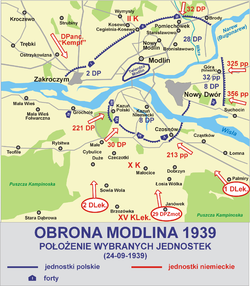| Battle of Modlin | |||||||
|---|---|---|---|---|---|---|---|
| Part of Invasion of Poland | |||||||
 Ruins of the southern bridgehead | |||||||
| |||||||
| Belligerents | |||||||
| Commanders and leaders | |||||||
| | | ||||||
| Units involved | |||||||
Polish Units | |||||||
| Strength | |||||||
| 4 infantry divisions 2nd Light Division Panzer Division Kempf 100 aircraft | 40,000 men (peak) 96 guns 7 TK-3 tankettes Armoured train "Śmierć" | ||||||
| Casualties and losses | |||||||
| 900 killed 670 wounded | 1,300 killed 4,000 wounded 35,000 captured | ||||||

The Battle of Modlin took place during the 1939 German invasion of Poland at the beginning of the Second World War. Modlin Fortress was initially the headquarters of the Modlin Army until its retreat eastwards. From 13 to 29 September 1939, it served as a defensive citadel for Polish forces under the command of General Wiktor Thommée against assaulting German units. The fighting was closely linked with the strategic situation of the Battle of Warsaw.
Contents
The Polish forces defending the fortress included the armoured train Śmierć ("death") and the Modlin anti-aircraft battery, which was credited with shooting down more Luftwaffe planes than any other in the entire September campaign.
Fortress Modlin capitulated on 29 September, one of the last to lay down its arms in the campaign, and surrendered 24,000 troops. [1] : 78 Several days earlier, Rochus Misch had attempted to negotiate the surrender of the fortress despite being wounded, an act for which he was awarded the Iron Cross. [2]
Soldiers of the Panzer Division Kempf committed the Massacre in Zakroczym on 28 September 1939.